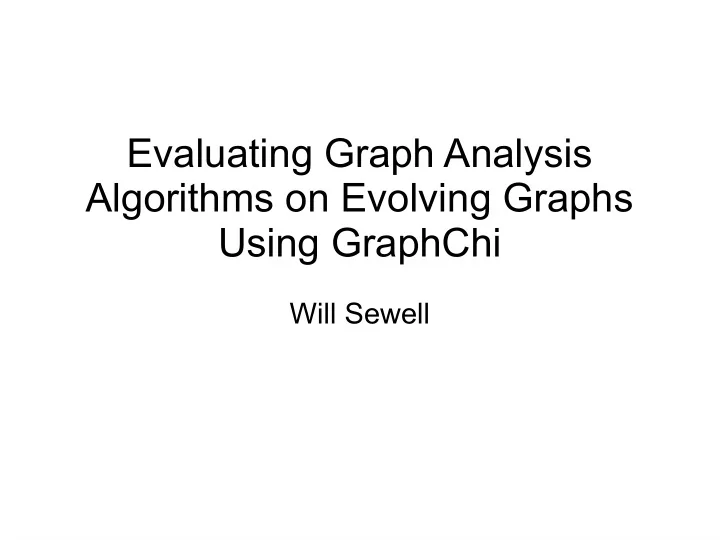

Evaluating Graph Analysis Algorithms on Evolving Graphs Using GraphChi Will Sewell
What Are Evolving Graphs? ● Also known as “iterative” or “dynamic” ● Where processing must be performed on graphs whose edges are constantly updating ● Algorithms perform incremental updates rather than re-computing values for the entire graph in batch
Motivation ● Why compute graph properties (PageRank, etc.) incrementally rather than statically? ● Performance – Most of the graph does not change, so properties will be the same ● Thus wasteful ● Timely updates – Graph updates visible rapidly
Approaches ● Still a relatively new area, with not much work ● Kineograph ● Naiad ● GraphChi
Why GraphChi? ● Interesting new algorithm ● Impressive Performance ● However paper seemed to present the evolving graphs as an afterthought – Therefore an interesting area for further work
The Dataset ● Amazon products ● Edges are “similar” products linked to from product detail pages ● 542,684 nodes; 1,231,398 edges ● The evolving property can be simulated by a script that incrementally builds up a new graph from this existing one
Test Algorithms ● GraphChi has many static graph processing algorithms that Amazon would likely want to compute on products – PageRank – Community Detection – Connected Components ● Plan to implement my own – Betweenness Centrality
Test Machine ● My Laptop! ● Exactly what GraphChi is targeted at
Planned Tests ● One test to measure the maximum number of streaming edges per second (e/s) the algorithm can handle – GraphChi paper does this, but only with a single algorithm – Can be plotted as a line with nodes e/s against iteration time ● Can control for rate of update as well as number of edges in each update
Planned Tests ● Example from GraphChi Paper (PageRank)
Planned Tests ● For the optimal edges e/s stream, I will measure the time taken to ingest the entire graph, as opposed to running it statically at varying intervals. – For this I can plot the point at which the evolving graph method overtakes the static method ● Will combine relative performances of all algorithms into a single graph for easier comparison
Expectations ● Some algorithms will perform well on a streaming graph, others will be extremely slow if all combinations edges/nodes are used in calculating properties ● These slower algorithms are unlikely to ever beat static graph analysis
Possible Extensions ● Compare results with another system that supports evolving graphs (Naiad) – May be able to test on a cluster to play to Naiad's strengths ● Try other centrality measures: – Louvain method – k-clique percolation method ● Huge number of other algorithms I could test
Any questions/suggestions?
Recommend
More recommend